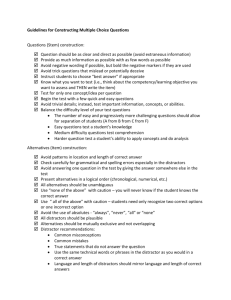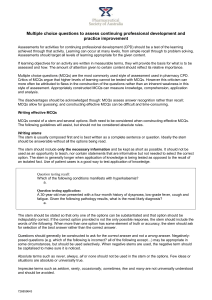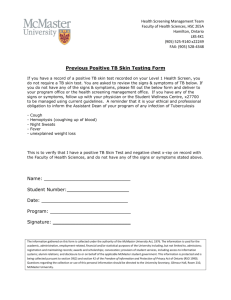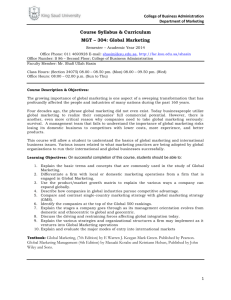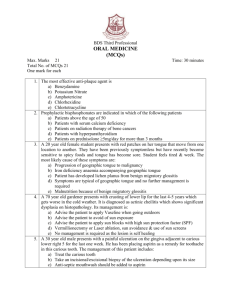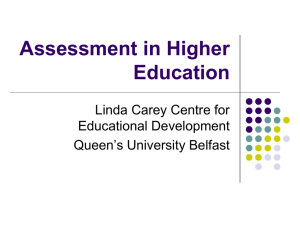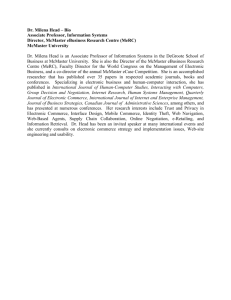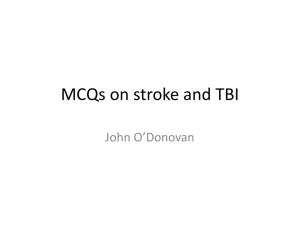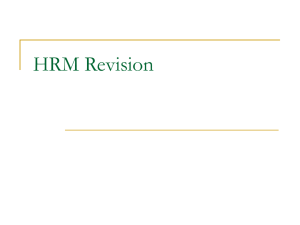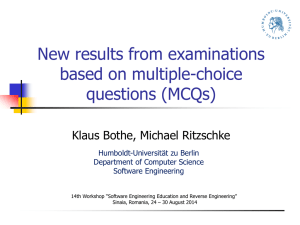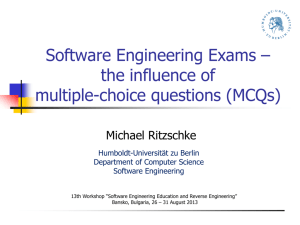How to Write Effective Multiple Choice Questionnaires
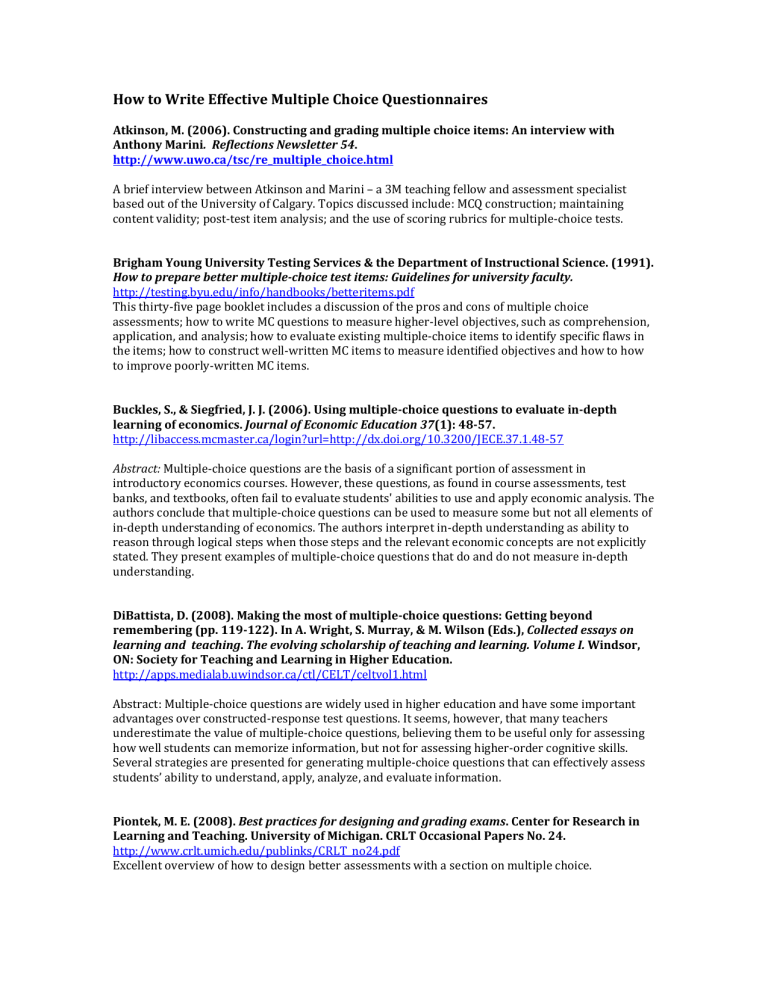
How
to
Write
Effective
Multiple
Choice
Questionnaires
Atkinson, M.
(2006).
Constructing and grading multiple choice items: An interview with
Anthony Marini .
Reflections Newsletter 54 .
http://www.uwo.ca/tsc/re_multiple_choice.html
A brief interview between Atkinson and Marini – a 3M teaching fellow and assessment specialist based out of the University of Calgary. Topics discussed include: MCQ construction; maintaining content validity; post‐test item analysis; and the use of scoring rubrics for multiple‐choice tests.
Brigham Young University Testing Services & the Department of Instructional Science.
(1991).
How to prepare better multiple choice test items: Guidelines for university faculty.
http://testing.byu.edu/info/handbooks/betteritems.pdf
This thirty‐five page booklet includes a discussion of the pros and cons of multiple choice assessments; how to write MC questions to measure higher‐level objectives, such as comprehension, application, and analysis; how to evaluate existing multiple‐choice items to identify specific flaws in
the items; how to construct well‐written MC items to measure identified objectives and how to how to improve poorly‐written MC items.
Buckles, S., & Siegfried, J.
J.
(2006).
Using multiple choice questions to evaluate in depth learning of economics.
Journal of Economic Education 37 (1): 48 57.
http://libaccess.mcmaster.ca/login?url=http://dx.doi.org/10.3200/JECE.37.1.48‐57
Abstract: Multiple‐choice questions are the basis of a significant portion of assessment in introductory economics courses. However, these questions, as found in course assessments, test banks, and textbooks, often fail to evaluate students' abilities to use and apply economic analysis. The authors conclude that multiple‐choice questions can be used to measure some but not all elements of in‐depth understanding of economics. The authors interpret in‐depth understanding as ability to reason through logical steps when those steps and the relevant economic concepts are not explicitly stated. They present examples of multiple‐choice questions that do and do not measure in‐depth understanding.
DiBattista, D.
(2008).
Making the most of multiple choice questions: Getting beyond remembering (pp.
119 122).
In A.
Wright, S.
Murray, & M.
Wilson (Eds.), Collected essays on learning and teaching .
The evolving scholarship of teaching and learning.
Volume I.
Windsor,
ON: Society for Teaching and Learning in Higher Education.
http://apps.medialab.uwindsor.ca/ctl/CELT/celtvol1.html
Abstract: Multiple‐choice questions are widely used in higher education and have some important advantages over constructed‐response test questions. It seems, however, that many teachers underestimate the value of multiple‐choice questions, believing them to be useful only for assessing how well students can memorize information, but not for assessing higher‐order cognitive skills.
Several strategies are presented for generating multiple‐choice questions that can effectively assess students’ ability to understand, apply, analyze, and evaluate information.
Piontek, M.
E.
(2008).
Best practices for designing and grading exams .
Center for Research in
Learning and Teaching.
University of Michigan.
CRLT Occasional Papers No.
24.
http://www.crlt.umich.edu/publinks/CRLT_no24.pdf
Excellent overview of how to design better assessments with a section on multiple choice.
Runte, R.
(2001).
How to construct better multiple choice tests.
University of Lethbridge Faculty of Education.
http://www.uleth.ca/edu/runte/tests/multiplechoicetests.html
Multiple‐Choice Construction Checklist: http://cll.mcmaster.ca/resources/pdf/runte.pdf
A multi‐part guide to constructing multiple‐choice tests, written by Dr. Robert Runte at the
University of Lethbridge. The advantages & disadvantages of multiple choice questions are outlined, and tips for all of the following are provided: writing good MCQs; the ordering/arrangement of questions; creating innovative MCQs; and using MCQs to test ‘higher level’ thinking. Illustrative examples are provided throughout.
See also the PDF document above, composed by Dr. Runte, which contains a checklist to aid in the
construction of MCQs, a sample Table of Specifications, and some guidelines for using post‐test item analysis to improve MCQ test design. Reproduced with permission.
University of Leicester.
The CASTLE Toolkit.
Designing & managing MCQs.
(2005).
http://www.le.ac.uk/castle/resources/mcqman/mcqcont.html
A thorough handbook pertaining to the construction of MCQs, originally prepared at the University of
Cape Town, and reproduced as part of the University of Leicester’s CASTLE Toolkit. Highlights include: the provision and analysis of specific question examples from three disciplines (education, sociology, economics); a discussion of scoring & statistics; and an appendix listing practical tips for authoring MCQs.
University of Waterloo Centre for Teaching Excellence.
CTE Teaching Tips.
(n.d.).
Designing multiple choice questions.
http://cte.uwaterloo.ca/teaching_resources/tips/designing_multiple_choice_questions.html
A concise listing of strategies for developing multiple‐choice questions (MCQs). General considerations are offered, as are best practices for developing question stems and response
alternatives.
Effective
Use
of
Multiple
Choice
Questionnaires
in
Your
Course
Butler, A.
C.
, & Roediger, H.
L.
(2008).
Feedback enhances the positive effects and reduces the negative effects of multiple choice testing.
Memory & Cognition 36 (3): 604 616.
http://libaccess.mcmaster.ca/login?url=http://dx.doi.org/10.3758/MC.36.3.604
Abstract: Multiple‐choice tests are used frequently in higher education without much consideration of the impact this form of assessment has on learning. Multiple‐choice testing enhances retention of the material tested (the testing effect); however, unlike other tests, multiple‐choice can also be detrimental because it exposes students to misinformation in the form of lures. The selection of lures can lead students to acquire false knowledge (Roediger & Marsh, 2005). The present research investigated whether feedback could be used to boost the positive effects and reduce the negative effects of multiple‐choice testing. Subjects studied passages and then received a multiple‐choice test
with immediate feedback, delayed feedback, or no feedback. In comparison with the no‐feedback condition, both immediate and delayed feedback increased the proportion of correct responses and reduced the proportion of intrusions (i.e., lure responses from the initial multiple‐choice test) on a delayed cued recall test. Educators should provide feedback when using multiple‐choice tests.
Yu, F.
Y., & Liu, Y.
H.
(2005).
Potential values of incorporating a multiple choice question construction in physics experimentation instruction.
International Journal of Science
Education 27 (11), 1319 1335.
http://www.informaworld.com.libaccess.lib.mcmaster.ca/10.1080/09500690500102854
The potential value of a multiple‐choice question‐construction instructional strategy for the support of students' learning of physics experiments was examined in the study. Forty‐two university freshmen participated in the study for a whole semester. A constant comparison method adopted to categorize students' qualitative data indicated that the influences of multiple‐choice question construction were evident in several significant ways (promoting constructive and productive studying habits; reflecting and previewing course‐related materials; increasing in‐group communication and interaction; breaking passive learning style and habits, etc.), which, worked together, not only enhanced students' comprehension and retention of the obtained knowledge, but also helped distil a sense of empowerment and learning community within the participants. Analysis with one‐group t ‐tests, using 3 as the expected mean, on quantitative data further found that students' satisfaction toward past learning experience, and perceptions toward this strategy's potentials for promoting learning were statistically significant at the 0.0005 level, while learning anxiety was not statistically significant. Suggestions for incorporating question‐generation activities
within classroom and topics for future studies were rendered.
Denyer, G., & Hancock, D.
(2002).
Graded multiple choice questions: Rewarding understanding and preventing plagiarism .
Journal of Chemical Education 79 (8): 961 964.
http://jchemed.chem.wisc.edu.libaccess.lib.mcmaster.ca/Journal/Issues/2002/Aug/PlusSub/V79N0
8/p961.pdf
This paper describes an easily implemented method that allows the generation and analysis of graded multiple‐choice examinations. The technique, which uses standard functions in user‐end software (Microsoft Excel 5+), can also produce several different versions of an examination that can be employed to prevent the reward of plagiarism. The manuscript also discusses the advantages of having a graded marking system for the elimination of ambiguities, use in multi‐step calculation questions, and questions that require extrapolation or reasoning. The advantages of the scrambling strategy, which maintains the same question order, is discussed with reference to student equity. The system provides a non‐confrontational mechanism for dealing with cheating in large‐class multiple‐ choice examinations, as well as providing a reward for problem solving over surface learning.
Instructions for setting up spreadsheets to allow graded marking of multiple‐choice‐question
examinations are available here .
Nicol, D.
(2007).
E assessment by design: using multiple choice tests to good effect.
Journal of
Further and Higher Education 31 (1), 53 64.
http://libaccess.mcmaster.ca/login?url=http://www.informaworld.com/openurl?genre=article&issn
=0309%2d877X&volume=31&issue=1&spage=53
Abstract: Over the last decade, larger student numbers, reduced resources and increasing use of new technologies have led to the increased use of multiple‐choice questions (MCQs) as a method of assessment in higher education courses. This paper identifies some limitations associated with MCQs from a pedagogical standpoint. It then provides an assessment framework and a set of feedback principles that, if implemented, would support the development of learner self‐regulation. The different uses of MCQs are then mapped out in relation to this framework using case studies of assessment practice drawn from published research. This analysis shows the different ways in which
MCQs can be used to support the development of learner self‐regulation. The framework and principles are offered as a way of helping teachers design the use of MCQs in their courses and of
evaluating their effectiveness in supporting the development of learner autonomy. A key message from this analysis is that the power of MCQs (to enhance learning) is not increased merely by better test construction. Power is also achieved by manipulating the context within which these tests are used.
Constructing
Multiple
Choice
Questionnaires
with
E
Learn
@
Mac
(ELM)
Video Tutorial – Assessments
http://www.ltrc.mcmaster.ca/elm/esupport/display.php?ID=149
A concise video that takes viewers through the processes of creating, administering & grading a quiz in ELM. An introduction to a variety of question types – including MCQs – is provided.
Quick Help Creating Multiple Choice Questions
http://www.ltrc.mcmaster.ca/elm/esupport/display.php?ID=24
Quick Help Creating Combination Multiple Choice Questions http://www.ltrc.mcmaster.ca/elm/esupport/display.php?ID=32
The above links offer a step‐by‐step breakdown of how to construct various types of MCQ in ELM.
